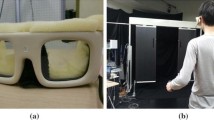Abstract
Walkers need to modify their ongoing actions to meet the demands of everyday environments. Navigating through openings requires gait modifications if the size of the opening is too small relative to the body. Here we ask whether the spatial requirements for navigating horizontal and vertical openings differ, and, if so, whether walkers are sensitive to those requirements. To test walkers’ sensitivity to demands for gait modification, we asked participants to judge whether they could walk through horizontal openings without shoulder rotation and through vertical openings without ducking. Afterward, participants walked through the openings, so that we could determine which opening sizes elicited gait modifications. Participants turned their shoulders with more space available than the space they left themselves for ducking. Larger buffers for horizontal openings may reflect different spatial requirements created by lateral sway of the body during walking compared to vertical bounce. In addition, greater variability of turning from trial to trial compared with ducking may lead walkers to adopt a more conservative buffer to avoid errors. Verbal judgments accurately predicted whether openings required gait modifications. For horizontal openings, participants’ judgments were best predicted by the body’s dynamic abilities, not static shoulder width. The differences between horizontal and vertical openings illustrate that walkers account for the dynamic properties of walking in addition to scaling decisions to body dimensions.



Similar content being viewed by others
References
Adolph KE, Cole WG, Komati M, et al. (in press) How do you learn to walk? Thousands of steps and hundreds of falls per day. Psychol Sci
Berger JO (1985) Statistical decision theory and Bayesian analysis. Springer, New York
Cole WG, Chan GLY, Vereijken B, Adolph KE (under review) Perceiving affordances for different motor skills. Manuscript under review
Comalli DM, Adolph KE (in prep) Infants’ gait modifications for navigating under barriers. Manuscript in preparation
Comalli DM, Franchak JM, Char A, Adolph KE (in prep) Younger and older adults’ perception of affordances for doorways and ledges. Manuscript in preparation
De Bujanda E, Nadeau S, Bourbonnais D (2004) Pelvic and shoulder movements in the frontal plane during treadmill walking in adults with stroke. J Stroke Cerebrovas Dis 13:58–69
Fajen BR, Riley MA, Turvey MT (2008) Information, affordances, and the control of action in sport. Int J Sports Psychol 40:79–107
Fajen BR, Diaz G, Cramer C (2011) Reconsidering the role of movement in perceiving action-scaled affordances. Hum Mov Sci 30:504–533
Fath AJ, Fajen BR (2011) Static and dynamic visual information about the size and passability of an aperture. Perception 40:887–904
Franchak JM, Adolph KE (2012) What infants know and what they do: perceiving possibilities for walking through openings. Dev Psychol 48:1254–1261
Franchak JM, van der Zalm D, Adolph KE (2010) Learning by doing: action performance improves performance perception. Vision Res 50:2758–2765
Gibson JJ (1979) The ecological approach to visual perception. Houghton Mifflin Company, Boston
Glimcher PW (2003) Decisions, uncertainty, and the brain: the science of neuroeconomics. MIT Press, Cambridge
Higuchi T, Cinelli ME, Greig MA, Patla AE (2006) Locomotion through apertures when wider space for locomotion is necessary: adaptation to artificially altered body states. Exp Brain Res 175:50–59
Higuchi T, Murai G, Kijima A, Seya Y, Wagman JB, Imanaka K (2011) Athletic experience influences shoulder rotations when running through apertures. Hum Mov Sci 30:534–549
Mark LS (1987) Eyeheight-scaled information about affordances: a study of sitting and stair climbing. J Exp Psychol Hum Percept Perform 13:361–370
Murray MP, Drought AB, Kory RC (1964) Walking patterns of normal men. J Bone Joint Surg 46A:335–360
Oudejans RRD, Michaels CF, Bakker FC, Dolné MA (1996) The relevance of action in perceiving affordances: perception of catchableness of fly balls. J Exp Psychol Hum Percept Perform 22:879–891
Stefanucci JK, Geuss MN (2010) Duck! Scaling the height of a horizontal barrier to body height. Atten Percept Psychophys 72:1338–1349
Trommershäuser J, Maloney LT, Landy MS (2008) Decision making, movement planning, and statistical decision theory. Trends Cogn Sci 12:291–297
van der Meer ALH (1997) Visual guidance of passing under a barrier. Early Dev Parent 6:149–157
Wagman JB, Malek EA (2008) Perception of affordances for walking under a barrier from proximal and distal points of observation. Ecol Psychol 20:65–83
Wagman JB, Malek EA (2009) Geometric, kinetic–kinematic, and intentional constraints influence willingness to pass under a barrier. Exp Psychol 56:409–417
Wagman JB, Taylor KR (2005) Perceiving affordances for aperture crossing for the person-plus-object system. Ecol Psychol 17:105–130
Warren WH (1984) Perceiving affordances: visual guidance of stair climbing. J Exp Psychol Hum Percept Perform 10:683–703
Warren WH, Whang S (1987) Visual guidance of walking through apertures: body-scaled information for affordances. J Exp Psychol Hum Percept Perform 13:371–383
Waters RL, Morris J, Perry J (1973) Translational motion of the head and trunk during normal walking. J Biomech 6:167–172
Weast JA, Shockley K, Riley MA (2011) The influence of athletic experience and kinematic information on skill-relevant affordance perception. Q J Exp Psychol 64:689–706
Wraga M (1999) Using eye height in different postures to scale the heights of objects. J Exp Psychol Hum Percept Perform 25:518–530
Yu Y, Bardy BG, Stoffregen TA (2011) Influences of head and torso movement before and during affordance perception. J Mot Behav 43:45–54
Acknowledgments
This research was supported by a National Institute of Health and Human Development Grant R37-HD33486 to Karen E. Adolph and a Dean’s Undergraduate Research Fund (DURF) Grant to Emma Celano. We gratefully acknowledge Angela Char, David Comalli, and the members of the NYU Infant Action Lab for helping with data collections and providing comments on the manuscript and thank Gladys Chan for her beautiful line drawings of the apparatus.
Author information
Authors and Affiliations
Corresponding author
Rights and permissions
About this article
Cite this article
Franchak, J.M., Celano, E.C. & Adolph, K.E. Perception of passage through openings depends on the size of the body in motion. Exp Brain Res 223, 301–310 (2012). https://doi.org/10.1007/s00221-012-3261-y
Received:
Accepted:
Published:
Issue Date:
DOI: https://doi.org/10.1007/s00221-012-3261-y




